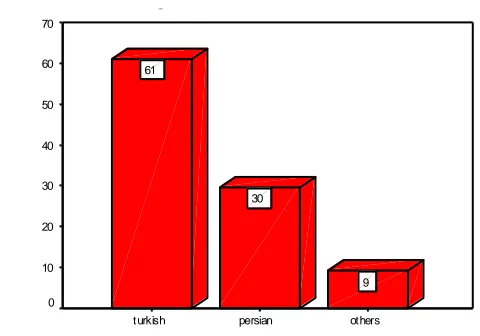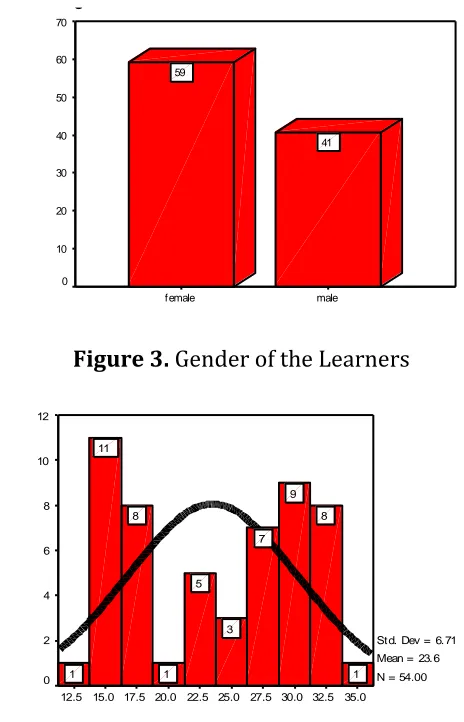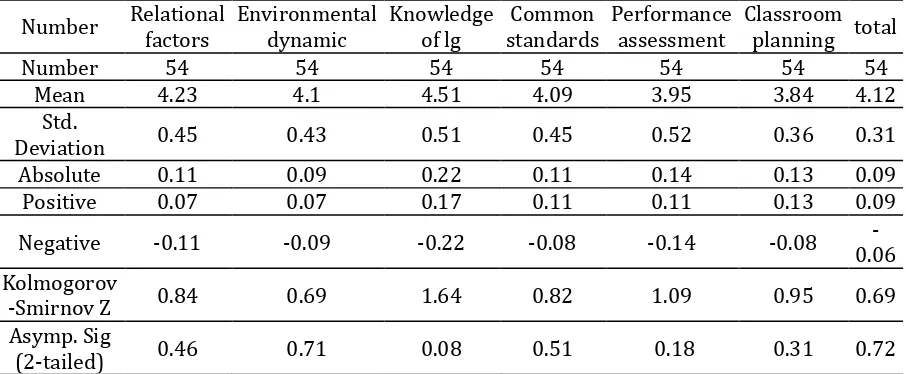Volume 3, Issue 2, 2016, pp. 148-156 Available online at www.jallr.com ISSN: 2376-760X
* Correspondence: Rasa Faramarz Zadeh, Email: rasafaramarzadeh@gmail.com © 2016 Journal of Applied Linguistics and Language Research
EFL Learners' Attitudes and Perceptions about an Effective
English Language Teacher
Rasa Faramarz Zadeh *
Teacher at Iran Language Institute, Iran
Abstract
Learning a foreign language requires mental, emotional and social interaction between teachers and learners. In the process of language learning, learners are as responsible as teachers and they can impose their own attitude toward effective teaching and also can improve teachers' profession. The present study attempts to investigate learners' perceptions and attitudes about effective teaching. The participants of this study are EFL learners from different language institutes in Tabriz who were requested to complete the questionnaire related to their ideas about effective EFL teachers. This questionnaire contains questions about different aspects of effective teacher including relational factors, environmental dynamic, knowledge of language, common standards, performance assessment, and classroom planning. The obtained findings revealed that all of these components are important in effective teaching from EFL learners' point of view.
Keywords: attitudes, perceptions, effective language teacher, EFL learners
INTRODUCTION
Effective Teaching
Effective teaching is a vast area of research and there are many factors contributing to effective teaching. According to Richards (2001), effective teaching is achieved not only because of how well teachers teach, but also through creating contexts and work environments that can facilitate good teaching. He believed these factors should be considered: institutional factors, teaching factors, teacher factors, and learner factor. Research offered a plethora of definitions of an effective teacher. Freeman and Richards (1996) claimed that "teachers are pivotal in the enterprise of teaching and learning" (p. 1). In a similar vein, Griffiths (2007) stated that "teacher practices and perceptions are critically important since they have the potential to influence the effectiveness of the teaching/learning process" (p. 91).
Clark (1993, p. 10) wrote that, "Obviously, the definition involves someone who can increase student knowledge, but it goes beyond this in defining an effective teacher." Vogt (1984) related effective teaching to the ability to provide instruction to different students of different abilities while incorporating instructional objectives and assessing the effective learning mode of the students.
Anderson (1991) stated that "an effective teacher is one who quite consistently achieves goals which either directly or indirectly focuses on the learning of their students" (p. 18). Although there seem to be universal general principles of effective teaching used to specify an effective teacher, the foreign and second language teaching presents learning objectives, tasks, and environments that are qualitatively distinct from those of other subjects. So, when defining the term "characteristics of effective language teacher," it’s necessary to take this context into consideration.
There is a study by Borg (2006) exploring ways in which language teachers are seen to be different to teachers of other subjects. This study investigates actual classroom practices of language teaching and other subjects and comes up with some factors. The factors that distinguish the experience of foreign language teachers from that of teachers of other subjects include the following: 1) The nature of the subject matter itself, 2) The interaction patterns necessary to provide instruction, and 3) The challenge for teachers of increasing their knowledge of the subject. Language teachers teach communication, not facts. 4) The need for outside support for learning the subject (Borg, 2006, p. 11-13).
Wichadee (2010) conducted a study to explore the characteristics of effective English teachers as perceived by students and teachers at Bangkok University, Thailand based on four categories: English proficiency, pedagogical knowledge, organization and communication skills, and socio-affective skills. The subjects were 400 students and 53 teachers who took or taught four basic English courses in the 2008 academic year. Data were collected using a five -point rating scale questionnaire. The findings revealed that the students placed a high level of importance on all of the characteristics included in the survey, with the highest ranking given to organization and communication skills. This contrasted with the teachers, who ranked English proficiency the highest. Moreover, the findings showed no significant differences between the perceptions of male students and female students.
Khojastehmehr and Takrimi (2009) identified teacher effectiveness factors, according to the perceptions of the English teachers in Khuzestan, Iran. Participants were 215 male and female secondary school English teachers, selected by a multistage sampling method. A 50-item researcher-constructed questionnaire was administered to these teachers, asking them what characteristics they thought effective English teachers should possess or demonstrate. A Principal Component Analysis was used, which yielded the following four factors: (a) instructional strategies, (b) communication (social) skills, (c) personal characteristics, and (d) knowledge. Results indicated that, to these teachers, instructional strategies were viewed as more critical for teacher effectiveness than other characteristics.
The present study investigates effective teaching from learners' point of view and based on the questions of the questionnaire, effective language teaching is divided into six categories including relational factors, environmental dynamic, knowledge of language, common standard, performance assessment, and classroom planning. Each of these categories is examined in the form of research hypotheses.
RESEARCH HYPOTHESES
1. Relational factors are effective in English language teaching from learners' point of view.
2. Environmental dynamic is effective in English language teaching from learners' point of view.
3. Knowledge of language is effective in English language teaching from learners' point of view.
4. Common standards are effective in English language teaching from learners' point of view.
5. Performance assessment is effective in English language teaching from learners' point of view.
METHODOLOGY
Design of the study
The design of this study was descriptive and a questionnaire was administered. In order to answer the research questions the reliability and the validity of the items of the questionnaire were ensured.
Participants
The participants of the present study were 92 (51 females and 41 male) EFL learners from different private English Institutes in Tabriz city on Iran. The mean score of participants' age is 23. Considering the educational status of the participants the results showed that 37%of them were at M.A. level, 25.9% were at B.A. level, 22.2 % were high school students and 14.8% were junior school students. In addition, the mother tongue of 61.1% of the participants was Turkish, 29.6% was Persian and 9.3% was other languages.
Figure 1. Educational Status of the Learners
Figure 2. Mother Tongue of the Learners education
education
junior school high school
M.A. B.A.
P
e
rc
e
n
t
40
30
20
10
0
15 22
37
26
mother tongue
mother tongue
others persian
turkish
P
e
rc
e
n
t
70
60
50
40
30
20
10
0
9 30
Figure 3. Gender of the Learners
Figure 4. Age of the Learners
Instruments
The instrument of this study is a 45 item questionnaire developed by Babai Shishavan (2010). The participants were asked to express their agreement or disagreement based on a five-point (strongly agree, agree, no idea, disagree, strongly disagree) Likert Scale. They were asked to select the choice which best represent their reaction to the statement. The internal consistency index of the questionnaire was calculated to be 0.83 using Cronbach’s Alpha.
This questionnaire includes 45 questions which was divided into six categories related to effective teaching. These categories include relational factors (questions: 26, 30, 31, 32, 34, 36, 37), environmental dynamic (questions: 19, 23, 24, 25, 27, 28, 29, 33), knowledge of language (questions: 1, 3, 4, 5, 6, 7, 8), common standards (questions: 2, 15, 35, 38, 39, 40, 41, 43, 45), performance assessment (22, 42, 46), and classroom planning (questions: 9, 10, 11, 12, 13, 14, 16, 17,18, 20, 21)
RESULTS AND DISCUSSION
In order to examine learners' attitude toward effective EFL teachers one sample t-test was administered to find out learners perception about different aspects of effective teaching. In addition, Kolmogorov-Smirnov test was used for detecting normal
gender
gender
male female
P
e
rc
e
n
t
70
60
50
40
30
20
10
0
41 59
AGE
35.0 32.5 30.0 27.5 25.0 22.5 20.0 17.5 15.0 12.5
AGE
F
re
qu
en
cy
12
10
8
6
4
2
0
Std. Dev = 6.71 Mean = 23.6 N = 54.00 1
8 9
7
3 5
1 8 11
distribution of variables; this test was used to estimate and ensure the normal distribution of variables and accordingly, the significance level is more than 0.05 which is considered to be normally distributed; therefore, it can be argued that parametric test is appropriate for this research.
Table 1. Results of Kolmogorov-Smirnov test
total Classroom planning Performance assessment Common standards Knowledge of lg Environmental dynamic Relational factors Number 54 54 54 54 54 54 54 Number 4.12 3.84 3.95 4.09 4.51 4.1 4.23 Mean 0.31 0.36 0.52 0.45 0.51 0.43 0.45 Std. Deviation 0.09 0.13 0.14 0.11 0.22 0.09 0.11 Absolute 0.09 0.13 0.11 0.11 0.17 0.07 0.07 Positive -0.06 -0.08 -0.14 -0.08 -0.22 -0.09 -0.11 Negative 0.69 0.95 1.09 0.82 1.64 0.69 0.84 Kolmogorov -Smirnov Z 0.72 0.31 0.18 0.51 0.08 0.71 0.46 Asymp. Sig (2-tailed)
In the following section the results of t-test and hypotheses testing are presented:
H1. Relational factors are effective in English language teaching from learners' point of view. Table 2 illustrates the mean score of questions related to relational factors, which is 4.23. In addition, according to Table 3 degree of freedom is 53, the mean difference is 1.23, the significance level is 0.00; since it is less than 0.05, it can be stated that learners with 95% confidence level believe that relational factors are influential as a component of effective EFL teachers.
Table 2. Mean of Relational Factors
Number Mean Standard deviation
Relational factor 54 4.23 0.45
Table 3.One Sample T-test
Test Value=3
Relational Factor
t df Sig.(2-tailed) difference Mean
95% Confidence Interval of the Difference Lower Upper
19.91 53 0.00 1.23 1.11 1.36
Table 4. Mean of Environmental Dynamic
Number Mean Standard deviation Environmental
Dynamic 54 4.1 0.43
Table 5. One Sample T-test
Test Value=3
Environmental Dynamic
t df tailed) Sig.(2- difference Mean
95% Confidence Interval of the Difference Lower Upper
18.81 53 0.00 1.1 0.99 1.22
H3. Knowledge of language is effective in English language teaching from learners'
point of view. Table 6 illustrates the mean score of questions related to knowledge of
language, which is 4.51. In addition, according to Table 7 degree of freedom is 53, the mean difference is 1.51, the significance level is 0.00; since it is less than 0.05, it can be stated that learners with 95% confidence level believe that knowledge of language is influential as a component of effective EFL teachers.
Table 6. Mean of Knowledge of Language
Number Mean Standard deviation Knowledge of
Language 54 4.51 0.51
Table 7. One Sample T-test
Test Value=3
Knowledge of Language
t df Sig.(2-tailed) difference Mean
95% Confidence Interval of the Difference Lower Upper
21.59 53 0.00 1.51 1.37 1.65
H4. Common standards are effective in English language teaching from learners' point of view. Table 8 illustrates the mean score of questions related to common standards, which is 4.09. In addition, according to Table 9 degree of freedom is 53, the mean difference is 1.09, the significance level is 0.00; since it is less than 0.05, it can be stated that learners with 95% confidence level believe that common standards are influential as a component of effective EFL teachers.
Table 8. Mean of Common Standards
Number Mean Standard deviation Common
Table 9. One Sample T-test
Test Value=3
Common
Standards t df Sig.(2-tailed)
Mean difference
95% Confidence Interval of the Difference Lower Upper
17.52 53 0.00 1.09 0.96 1.21
H5. Performance assessment is effective in English language teaching from learners' point of view. Table 10 illustrates the mean score of questions related to performance assessment, which is 3.95. In addition, according to Table 11 degree of freedom is 53, the mean difference is 0.95, the significance level is 0.00; since it is less than 0.05, it can be stated that learners with 95% confidence level believe that performance assessment is influential as a component of effective EFL teachers.
Table 10. Mean of Performance Assessment
Number Mean Standard deviation Performance
Assessment 54 3.95 0.52
Table 11. One Sample T-test
Test Value=3
Performance Assessment
t df Sig.(2-tailed) difference Mean
95% Confidence Interval of the Difference Lower Upper
13.23 53 0.00 0.95 0.8 1.09
H6. Classroom planning is effective in English language teaching from learners' point of view. Table 12 illustrates the mean score of questions related to classroom planning, which is 3.84. In addition, according to Table 13 degree of freedom is 53, the mean difference is 0.84, the significance level is 0.00; since it is less than 0.05, it can be stated that learners with 95% confidence level believe that classroom planning is influential as a component of effective EFL teachers.
Table 12. Mean of Classroom Planning
Number Mean Standard deviation Classroom
Planning 54 3.84 0.36
Table 13. One Sample T-test
Test Value=3
Classroom
Planning t df Sig.(2-tailed)
Mean difference
95% Confidence Interval of the Difference Lower Upper
DISCUSSION AND CONCLUSION
Teaching a foreign language requires gaining mastery of different qualifications by EFL instructors. These teachers are supposed to teach a foreign or second language to the learners with different educational background with different intentions. It is believed that learners themselves can take part actively in the course of language teaching by providing teachers with their own ideas and interests; this can later improve language-learning process and teachers will be able to expand their career and learn mutually. The results obtained from this study revealed that there are various factors, which can influence the effectiveness of language teaching and learners are able to pronounce their own ideas about it.
Based on the finding, it can be concluded that all of the components of effective teaching proposed by the researcher are influential in the course of effective teaching and learners believed that relational factors, environmental dynamic, knowledge of language, performance assessment, classroom planning and common standards can be considered to be important as criteria for effective EFL teachers. That is to say, learners believe that an effective teacher need to have good and friendly relationship with them, be able to speak well and pronounce words accurately, be helpful to them about language use out of class, be updated and familiar with the foreign culture. Also, evaluate them regularly and give them useful feedback, and have rigid planning and management about course books and methodology. Nearly all of these aspects are the ones included in teacher training courses and all teachers require gaining mastery in these components in order to be professional and effective teacher.
The results of this study can help EFL teachers to become aware of the aspects and features of language teaching which are important from learners' point of view; these points can reveal the needs and expectations of learners about their teachers. Besides, further studies can be conducted about difference between male and female leaners' perceptions about effective teachers. In addition, learners' level of language proficiency can be considered in investigating their attitudes.
REFERENCES
Anderson, L. W. (1991). Increasing Teacher Effectiveness. Paris: UNESCO, International Institute for Educational Planning.
Borg, S. (2006). The distinctive characteristics of foreign language teachers. Language
Teaching Research, 10 (1), 3–31.
Clark, D. (1993). Teacher evaluation: A review of the literature with implications for
educators. Unpublished Seminar Paper, California State University at Long Beach.
Freeman, D., & Richards, J. C. (Eds.). (1996).Teacher learning in language teaching. New York: Cambridge University Press.
Griffiths, C. (2007). Language learning strategies: Students' and teachers' perceptions.
ELT Journal, 61 (2), 91-99.
Richards, J. C. (2001). Curriculum development in language teaching. Cambridge, UK: Cambridge University Press.




